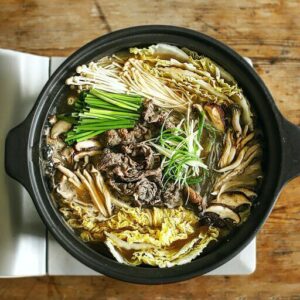Korean cuisine has captured the hearts and taste buds of food enthusiasts around the world. With its diverse range of flavors, textures, and vibrant presentation, it’s no wonder that Korean dishes have become beloved favorites. In this article, we present you with 10 classic Korean recipes that you absolutely must try today. From street food delights to hearty stews and sizzling BBQ, prepare to embark on a culinary journey through the rich tapestry of Korean flavors.
I. Tteokbokki (Spicy Rice Cake)
 Tteokbokki is a beloved Korean street food known for its fiery and addictive flavors. Made with chewy rice cakes bathed in a spicy sauce, it’s a dish that packs a punch. Here’s how to make it:
Tteokbokki is a beloved Korean street food known for its fiery and addictive flavors. Made with chewy rice cakes bathed in a spicy sauce, it’s a dish that packs a punch. Here’s how to make it:
- Prepare the tteok (rice cakes) and the sauce ingredients.
- Boil the tteok until they become soft and chewy.
- Mix the sauce ingredients and simmer until thickened.
- Add the tteok to the sauce and stir-fry until well-coated.
- Serve hot and garnish with sesame seeds and chopped green onions.
II. Bulgogi (Marinated Beef)
 Bulgogi, meaning “fire meat,” is a quintessential Korean BBQ dish that showcases the harmony of sweet and savory flavors. Get ready to tantalize your taste buds with this recipe:
Bulgogi, meaning “fire meat,” is a quintessential Korean BBQ dish that showcases the harmony of sweet and savory flavors. Get ready to tantalize your taste buds with this recipe:
- Slice the beef thinly and prepare the marinade ingredients.
- Marinate the beef for at least 30 minutes or overnight for maximum flavor.
- Heat a grill or a pan and cook the marinated beef until tender and slightly charred.
- Serve the bulgogi with steamed rice and a side of lettuce for wrapping.
III. Kimchi (Fermented Vegetables)
Kimchi is a staple in Korean cuisine and a culinary marvel. This fermented vegetable dish offers a delightful combination of tanginess, spiciness, and umami. Let’s dive into the world of kimchi:
- Cut the cabbage into pieces and salt them to draw out excess moisture.
- Rinse the cabbage and prepare the kimchi paste with garlic, ginger, chili flakes, and other ingredients.
- Rub the cabbage leaves with the kimchi paste, making sure they are well-coated.
- Transfer the kimchi to a jar and let it ferment for a few days at room temperature.
- Once fermented, store the kimchi in the refrigerator to slow down the fermentation process.
IV. Bibimbap (Mixed Rice Bowl)
Bibimbap is a colorful and wholesome Korean dish that features a variety of vegetables, meat, and a fried egg, all served over a bed of rice. Let’s create a stunning bibimbap:
- Prepare the vegetables by blanching or sautéing them individually.
- Marinate and cook the meat, such as beef or chicken, to your liking.
- Cook the rice and place it in a bowl as the base.
- Arrange the cooked vegetables
V. Bibimbap (Mixed Rice Bowl)
Bibimbap is a colorful and wholesome Korean dish that features a variety of vegetables, meat, and a fried egg, all served over a bed of rice. Let’s create a stunning bibimbap:
- Prepare the vegetables by blanching or sautéing them individually.
- Marinate and cook the meat, such as beef or chicken, to your liking.
- Cook the rice and place it in a bowl as the base.
- Arrange the cooked vegetables and meat in separate sections on top of the rice.
- Fry an egg and place it in the center of the bowl.
- Serve with a dollop of gochujang (Korean chili paste) and mix everything together before eating.
VI. Japchae (Stir-Fried Glass Noodles)
Japchae is a savory and satisfying Korean noodle dish made with glass noodles, vegetables, and a flavorful sauce. Here’s how to make it:
- Boil the glass noodles until they are cooked but still chewy.
- Stir-fry vegetables such as carrots, bell peppers, and spinach.
- In a separate pan, cook the marinated meat, usually beef or pork.
- Combine the cooked noodles, vegetables, and meat together.
- Add the sauce mixture and toss everything until well-coated.
- Garnish with sesame seeds and sliced green onions before serving.
VII. Samgyetang (Ginseng Chicken Soup)
Samgyetang is a nourishing and comforting Korean soup made with a whole chicken, ginseng, and various herbs. Follow these steps to prepare this wholesome dish:
- Clean and stuff the chicken with glutinous rice, garlic, and jujubes.
- Place the stuffed chicken in a pot and add water, ginseng, and other herbs.
- Simmer the soup for a few hours until the chicken is tender and the flavors are infused.
- Serve the samgyetang hot, garnished with sliced scallions and a sprinkle of salt.
VIII. Haemul Pajeon (Seafood Pancake)
Haemul pajeon is a delicious Korean pancake loaded with seafood and green onions. Try out this recipe for a delightful treat:
- Make the pancake batter by combining flour, eggs, water, and salt.
- Heat a pan with oil and spread the batter evenly.
- Arrange a mixture of seafood like shrimp, squid, and clams on top.
- Add a generous amount of chopped green onions.
- Cook the pancake until golden brown on both sides.
- Cut it into slices and serve hot with a dipping sauce made from soy sauce, vinegar, and sesame oil.
IX. Galbi (Grilled Short Ribs)
Galbi is a popular Korean BBQ dish made with marinated beef short ribs. Here’s how to prepare this succulent delight:
- Prepare the marinade by combining soy sauce, sugar, garlic, ginger, and sesame oil.
- Marinate the beef short ribs for at least a few hours or overnight for maximum flavor.
- Grill the marinated ribs on a hot grill or a preheated pan until cooked to your desired level of doneness.
- Serve the grilled galbi with steamed rice, kimchi, and other banchan (side dishes) for a complete Korean BBQ experience.
X. Sundubu-jjigae (Soft Tofu Stew)
Sundubu-jjigae is a spicy and comforting Korean tofu stew that will warm your soul. Follow these steps to make this satisfying dish:
- Heat a pot and add some vegetable oil.
- Sauté aromatics like onions, garlic, and chili flakes until fragrant.
- Add diced vegetables such as zucchini, mushrooms, and carrots.
- Pour in the broth and bring it to a simmer.
- Add soft tofu and gently stir to combine.
- Season with soy sauce, salt, and pepper to taste.
- Crack an egg into the stew and let it cook.
- Garnish with chopped green onions and serve piping hot with a side of steamed rice.
Congratulations! You’ve now discovered 10 classic Korean recipes that will transport you to the vibrant world of Korean cuisine. From the fiery flavors of tteokbokki to the comforting warmth of sundubu-jjigae, these dishes showcase the diverse range of Korean culinary delights. Whether you’re a seasoned cook or just beginning your culinary journey, these recipes offer a perfect balance of flavors and techniques that will impress your taste buds and leave you craving for more.
Get ready to explore the rich tapestry of Korean flavors, gather the necessary ingredients, and embark on a culinary adventure right in your own kitchen. So put on your apron, grab your utensils, and let’s delve into the world of Korean cooking. It’s time to savor the authentic tastes and experience the joy of creating these classic Korean dishes. Happy cooking!
